Section Two
PUTTING IN THE PLANETS
The second part in making a horoscope is a more puttering job than the first in actual practice, but it is not nearly as difficult to understand because there are far less details to learn at the beginning or thereafter to continue to take into account. It really provides a much greater interest than establishing the position of the houses in the heavens at a moment and place of birth and then identifying their cusps in the necessary correspondence with the zodiac in which the planets are located, since after all it is only as these astrological significators are finally placed one by one in the wheel-diagram that the horoscopic potentials begin to reveal themselves in very fascinating fashion.
Attention now goes wholly to the ephemeris, and all concern at this point is with the simple interrelations in the zodiac of the celestial factors brought to focus and meaning in a horoscope. The zodiacal positions of the ten major planets commonly employed for astrological analysis are given daily either for the zero hour beginning the day or for noon in the considerable number of ephemerides available as this revision of text is prepared. In all these tabulations in current use the planetary places are shown for the prime meridian established at Greenwich in England, as presumably of the greatest worldwide convenience, and an initial step in locating the significators in the horoscopic wheel-diagram is to make an adjustment to this 0° of geographic longitude thus taken as a basis for the tables.
Although the moon is a satellite of the earth rather than the sun, and the sun in astrology is surrogate for the terrestrial globe through taking on its motion geocentrically, these two bodies while known especially as the lights are not distinguished functionally from the eight true planets given horoscopic consideration. All ten celestial factors are treated alike in the ephemeris.
The Two Phases
There are two quite separate phases in the task of locating the planets in the horoscope. The first is a general adjustment concerning all of them, and the second is the specific calculation for each of them individually. The initial or preliminary attention is demanded by the fact that their positions in the ephemeris are given for a midnight or noon at the Greenwich meridian, and that in the case of virtually any horoscope this is a time quite different from the hour and minute of birth shown locally for the event. Thus when it is one o'clock in the morning in New York City it is around sunrise in London, and this obviously is a very important matter to take into account when using an ephemeris computed for Greenwich. Naturally it would be much too expensive to have a separate set of tables each year for every time zone around the globe. As it happens, the solution of this rather superficial problem is absurdly simple.
The Birth in Greenwich Mean Time
When it comes to finding the places of the planets in the zodiac at the moment of birth, and these are available for midnight or noon at the Greenwich prime meridian in an annual ephemeris, all that is necessary in order to use the tabulations handily is to change the time of birth into the equivalent hours and minutes at Greenwich. The result of this operation is the Greenwich mean time of the given horoscope and this usually is abbreviated as the G.M.T. and in the best practice is noted in or near the basic diagram for purposes of reference along with the S.T. and T.D. and of course the birth data. The T.D. or general time difference between the L.M.T. and the mean time at the Greenwich meridian has already had necessary consideration in putting up the horoscope, since a correction from mean to sidereal measure was necessary in the adjustment for the distance in terrestrial longitude from the prime meridian, and it must now be employed again if for a different purpose.
In the first example horoscope as a case where birth is west of Greenwich or where the sun arrives at the prime meridian first, the T.D. of 4h 56m is added to the L.M.T. of 3:06 p.m. to identify the corresponding Greenwich mean time as 8:02 p.m. Further consideration, in the task of putting in the planets and completing the erection of any horoscope, is with this Greenwich mean time for the individual wheel-diagram at all points. Parenthetically, there is a possibility of confusion on the beginner's part that might lead to a serious misplacement of the fast-moving moon. Ideally the G.M.T. is on the same day as birth, and perhaps in the same division of the day as p.m. for both L.M.T. and G.M.T. in the first example chart. In the fourth example the L.M.T. is a.m. and the G.M.T. is p.m., but on the same day. In the second example the L.M.T. is p.m. and the G.M.T. is a.m. the next day. Difficulty is avoided here if attention is held strictly to the G.M.T. when computing planetary positions. It makes no difference whatsoever if either the G.M.T. or its previous midnight or noon fails to fall in the birthday. The third example as a case of birth east of Greenwich has the possible p.m. birth and a.m. G.M.T. on the same day.
Calculating Planetary Position
The second of the two phases in the task of locating the planets in the horoscope is a separate proposition for each of them because they seldom move through the zodiac at the same rate of speed and in that case cover equal distances in the celestial or zodiacal longitude. The sun has the most regular movement of the ten significators in general acceptance, and can serve well as a preliminary and suppositional example. Thus in 1969 on March 6th at noon Greenwich it is found in Pisces 15°44'33" and on March 7th at noon Greenwich in Pisces 16°44'34" or a single second of arc over an even degree of motion. Since 1" as around a four-thousandth part of its daily movement is altogether too inconsequential to take into account, even if great precision is desired, the daily motion on this date can be taken as an even 1° and for convenience converted to 60'. If it be assumed that somebody is born somewhere on the Greenwich meridian at midnight between March 6th and 7th, the problem of finding the sun's place in his horoscope is simple. Twelve hours have elapsed since the sun was at Pisces 15°44'33" and it will be twelve hours before it gets to Pisces 16°44'34". In other words, at the time of birth it has gotten halfway to where it is going in this particular twenty-four hours. In the whole twenty-four it will move the rounded 60' and in half that time it will move the approximate 30' or to its horoscopic position of Pisces 16°14'33" or Pisces 16°15'. The rounding from seconds to minutes is by the usual mathematical procedure explained in connection with putting up the wheel.
The Example Horoscopes
Example I presents a G.M.T. of 8:02 p.m., as already noted in a preceding paragraph. This provides a relatively simple task of calculation of planetary position since in a noon ephemeris a virtually even third of the twenty-four hours has elapsed from the previous noon to the moment of birth. The 2m over the 8h or exact third of a day are only 1/240 of the 8h and consequently of no possible significance. On July 4th at Greenwich noon the sun is at Cancer 12°19'3" and on the 5th at Greenwich noon it reaches Cancer 13°16'14". The latter rounds to 13°16' and then, to permit subtraction, can be taken as 12°76'. The position on the 4th is rounded to 12°19', which is subtracted from 12°76' to find the sun's movement in this twenty-four hours to be 57', and a third of which or 19' is then found to be the movement from noon to birth and added to Cancer 12°19' to identify the sun's place in the horoscope as Cancer 12°38'.
One of the most common mistakes made by astrologers, and on rare occasions by the most skillful, is omitting twelve hours in computing the S.T. of the individual midheaven when working from a previous noon found on a prior day for an a.m. L.M.T. As soon as the sun's position has been found in setting up any chart, there should be the quick and easy routine check to make sure the house circle has been placed correctly in the heavens. Obviously the greater light can never be in the fifth house for a midmorning birth. In the present instance the eighth house is a proper place at a midafternoon birth on a day when sunset is at 7:36 p.m. L.M.T.
In the case of this first example, Mercury in twenty-four hours moves from 23°42' to 25°21' in Gemini. The July 5th noon position of 25°21' can be expressed as 24°81' from which 23°42' is subtracted to show 1°39' or 99' to be its daily motion. A third of 99' or 33' added to Gemini 23°42' locates the planet in the horoscope at Gemini 23°75' or 24°15'. Venus similarly is found to have a daily motion of 1°3' or 63' of which a third or 21' is added to Taurus 27°28' to give its location at Taurus 27°49'.
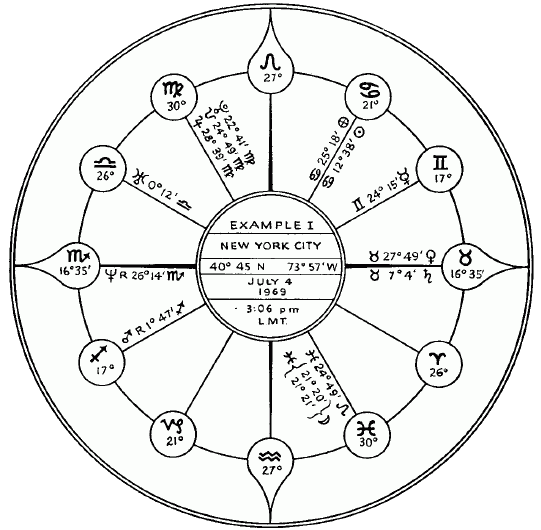
Time difference: 4h 56m
Greenwich mean time: 8:02 p.m.
Mars here becomes an exceptional but not uncommon proposition since the planet is retrograde. The phenomenon of retrogradation has been explained in Chapter Six, and the calculation of its position involves no difficulty since it is simply performed in reverse. From Sagittarius 1°48' on July 4th it moves back to Sagittarius 1°45' by the next noon. This is a movement of 3' of which a third is 1'. The position in the horoscope therefore is Sagittarius 1°47' and this is marked with an R to indicate the retrogradation. Something that may be largely a matter of taste, but that at best can be a real refinement of analysis, is attention to the nearness of the stationary point in an immediate past or future. Some astrologers note this by indicating SR for stationary going retrograde or about to go retrograde or recently gone retrograde, and by SD for the contrary case of change to direct motion. This is a subtle point about which the beginner should be informed, but a practice that he might at the start find more confusing than helpful. Mars in this example instance will go direct in four days, but on July 4th it nonetheless is retrograde.
Jupiter moves 7' in the twenty-four hours and 2' taken as nearest to an even third establishes its position at Virgo 28°39'. Saturn's daily motion at this time is 5' of which the nearest third again is 2' to locate it at Taurus 7°4'. Uranus moves only 1' forward and Neptune 1' backward in the twenty-four hours and their positions are taken for the nearest noon or Libra 0°12' and Scorpio R 26°14' respectively. Pluto similarly is Virgo 22 degrees°41'. Many old-time astrologers did not trouble themselves to correct the positions of the outermost planets, but used the nearest position shown in the ephemeris for their horoscopes. This practice might never mean any significant neglect of indication, but it can take the edge off a proper refinement of consideration in respect to aspects and progression.
It may be somewhat more complex to put the moon in position by this fractional estimation method, but it does not have to be any more difficult. The moon at noon on July 5th in this example case lies at Aries 0°24', and for purposes of subtraction this can be expressed as Pisces 30°24' and then Pisces 29°84'. Its position at noon on the 4th at Pisces 16°48' can thus be subtracted to reveal a daily motion of 13°36'. Most simply a third first of the 12° is 4° and of the residue of 1°36' expressed as 96' is 32' as the balance of the third part sought or a total of 4°32' to add to Pisces 16°48' and locate the moon in the wheel-diagram at Pisces 20°80' or 21°20'.
It is suggested in Chapter Seven that the beginner should be familiar with three commonly employed zodiacal factors of relatively minor importance that otherwise have no consideration in this introductory text. By the same token however he should know how to locate them in the horoscopic chart. The moon's node (by which is meant its north node) is known familiarly as the dragon's head and is included in the ephemeris, but its positions are not given for every day. Nonetheless it is easy to place it in the wheel-diagram by fractional estimation. Its position at noon on July 3, 1969, is at Pisces 24°54' and on July 5th at Pisces 24°47' by what is always retrograde motion and therefore not so marked. This is 7' of motion for two days, but actually the movement is only a shade over 3' a day. The first example horoscope requires an adjustment of a third of the daily motions of the planets from their place of July 4th, and this place of the north node nearer the noon of the 5th than of the 3rd suggests taking two thirds from the position on the 5th. Here 2' by addition because of the retrograde motion places it at Pisces 24°49'.
The Part of Fortune lies at the distance it must move forward in the zodiac to reach the ascendant that the moon must move similarly to reach its next conjunction with the sun. This is easily calculated by adding the zodiacal longitude in the horoscope of the moon to that of the ascendant, and from the sum subtracting that of the sun to get the zodiacal longitude of the part. Technically this means taking signs and fractions of signs as in usual mathematical procedure, but astrologers find it easier to take the number of the sign in its order in the zodiac and then its degrees and minutes and this produces the same result thus:
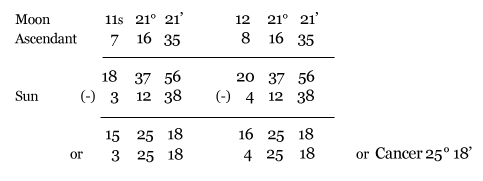
Example II The T.D. of 5h 51m added to the L.M.T. of 10:09 p.m. gives a G.M.T. of 4:00 a.m. on the next day or December 26th. The elapsed time from the previous noon is thus an even two-thirds of the twenty-four hours. The computations of the first example could be repeated quite precisely by subtracting a third of the daily motions of the planets from their positions at noon on the 26th. Calculating from a midnight ephemeris however can again be by an easy fraction since four hours is a sixth of the twenty-four. The sun at midnight beginning the 27th is at Capricorn 5°3'38" and on the 26th at midnight at Capricorn 4°2'31" with a daily motion of 1°1'7" or 61'7" or 60'67" of which a sixth is 10'11" to add to Capricorn 4°2'31" to show the sun's horoscopic place to be Capricorn 4°12'42" rounded to Capricorn 4°13'.
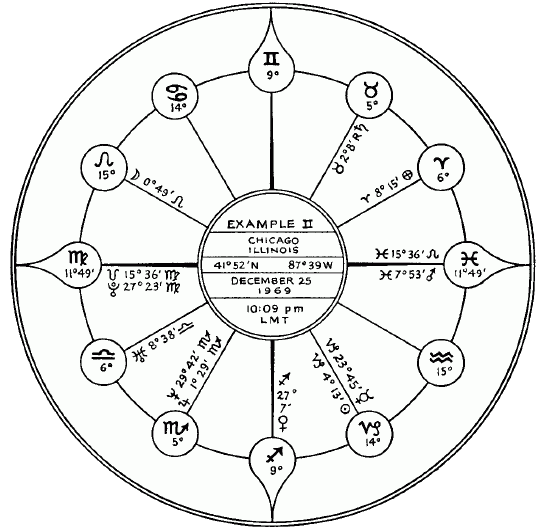
Time difference: 5h 51m
Greenwich mean time: 4:00 a.m.
The moon at midnight on December 27th is at Leo 10°40' which is expressed as Cancer 39°100' to permit the subtraction of its midnight position on the 26th of Cancer 28°51'. The daily motion thus obtained of 11°49' is very close to an even 12° of which a sixth would be an even 2°, and in such an instance as this the approximation would serve all practical purposes quite adequately. Actually the difference between the sixth of an even 12° and of the 11°49' would amount to less than 2' and this example chart can be prepared more precisely by deducting the 2' from 2° or 1°60' and adding 1°58' to the moon's position at midnight on December 26th of Cancer 28°51' to get Cancer 29°109' or Cancer 30°49' or Leo 0°49' as the location for the moon in the second example wheel. But at this point it is obvious that the beginner cannot be expected to work through a complication of approximations with any confidence or competence. Except in such very simple and obvious instances as have been employed to give him the general idea of what he is doing in his calculations, he needs something more fixed or constant in application for the far more unusual computations he will be encountering rather continually. This need is met by the especially calculated diurnal proportional logarithms.
The Use of Logarithms
The beginner is learning to use an ephemeris and a Table of Houses without any necessity of mastering the mathematics behind them, and in the same fashion he can use the special type of logarithms prepared for astrological operations without need to concern himself over the mechanics of applying geometrical proportion to irregularities. He has been dealing on the one side with the daily or twenty-four-hour motion of the planetary bodies, and on the other with the extent to which each planet must move to reach its horoscopic position. He has seen that the factor determining the latter is the time elapsing from the midnight or noon of the ephemeris to the moment of birth, and by the simple device of adding the special logarithm of this lesser time span to the special logarithm of the zodiacal movement of a particular planet in a whole twenty-four hours he has the logarithm of the zodiacal span the planet in question must traverse to reach its horoscopic place.
Thus in connection with the second example chart he can perform the logarithmic calculation as follows:
| Moon's daily motion, December 26th: | 11° 49' | Logarithm: | .3077 | |
| Time elapsed from midnight (26th): | 4h | ditto | .7781 | |
| ______________________ | ||||
| By addition: | ditto | 1.0858 | ||
which shows (nearest to 1.0865) 1°58' to be the desired movement for the planet in reaching its horoscopic place. This added to the midnight position, Cancer 28°51', gives Cancer 29°109' or 30°49' or Leo 0°49' in exact agreement with the results of fractional approximation. The logarithmic procedure may take a little more time, but in anything other than the very obvious case of actual simple fractions it is far safer for the beginner.
Returning to Example I, the computations for Mercury can be repeated with the use of logarithms, thus:
| Mercury's daily motion, July 4th: | 1° 39' | Logarithm: | 1.1627 | |
| Time elapsed from noon (4th): | 8h 2m | ditto | .4753 | |
| ______________________ | ||||
| By addition: | 1.6380 | |||
which shows (nearest to 1.6398) 33' as the distance the planet must move to its place. This added to the noon position, Gemini 23°42', gives Gemini 23°75' or 24°15' as the horoscopic location of this significator.
Venus can be taken as a further example of calculation for the planets of lesser daily motion, thus:
| Daily motion of Venus, July 4th: | 1° 3' | Logarithm: | 1.3590 | |
| Time elapsed from noon (4th): | 8h 2m | ditto | .4753 | |
| ______________________ | ||||
| By addition: | 1.8343 | |||
which shows (nearest to 1.8361) 21' to be added to the noon position of this planet, Taurus 27°28', to show its horoscopic place as Taurus 27°49'.
Where the use of logarithms is most helpful in making a horoscope is of course in the calculation of the moon's position, and the procedure is as simple as can be seen again with Example I as follows:
| Moon's daily motion, July 4th: | 13° 36' | Logarithm: | .2467 | |
| Time elapsed from noon (4th): | 8h 2m | ditto | .4753 | |
| ______________________ | ||||
| By addition: | .7220 | |||
which shows (nearest to .7222) 4°33' to be added to Pisces 16°48' to locate the planet in the wheel at Pisces 20°81' or 21°21' and with a deviation of only 1' from the result obtained by fractional estimation.
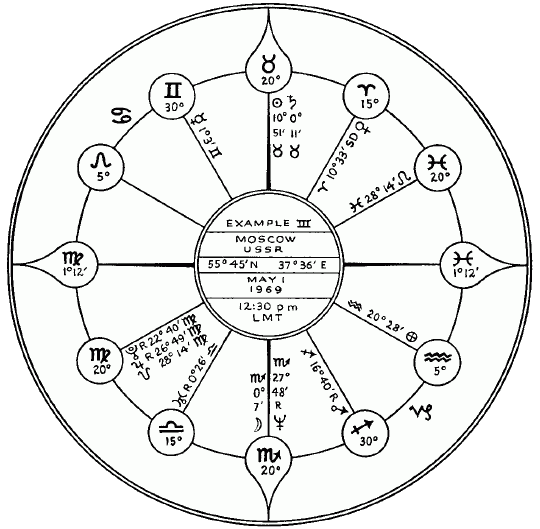
Time difference: 2h 30m (minus)
Greenwich mean time: 10:00 a.m.
While professionals generally use the logarithms for calculating the moon's position, if at all, beginners tend to employ them for most of the planets. To be noted is that one same logarithm is used for all the significators, as .4753 above for the elapsed time from a previous midnight or noon, and in consequence it is often identified as the constant logarithm.
Example III The T.D. of 2h 30m subtracted from the L.M.T. of 12:30 p.m. because of birth east of the Greenwich prime meridian gives a G.M.T. of 10:00 a.m. on the same day. In this instance the period of two hours before noon means that planets have yet to move a twelfth of their daily motion to reach their places at noon in the noon ephemeris, and so the calculation of their horoscopic positions is most conveniently or commonsensically a matter of subtraction whether the amount of their twenty-four-hour motion not used in gaining their natal places is found by fractional estimation or through the use of logarithms. Mercury's daily motion if using a noon ephemeris is 1°21' or 84' of which a twelfth is 7' and that subtracted from Gemini 1°10' gives Gemini 1°3'. The logarithm for 1°21' or 1.2499 added to the logarithm for 2h or 1.0792 is logarithm 2.3291 for 7'. The beginner must observe that the logarithms still have to be added even if the result is to be subtracted.
Example IV The T.D. of 3h 53m added to the L.M.T. of 9:37 a.m. gives a G.M.T. of 1:30 p.m. of the same day. With a noon ephemeris the fractional estimation would be on the basis of a sixteenth of the daily motion of each of the planets. It is easier, however, to use more than a single fraction in order to work with readily familiar ones as perhaps taking a twelfth and decreasing it by a quarter of itself or taking a quarter of a quarter. From midnight a half increased by an eighth would be accurate. With slow-moving planets the approximating fractions can become very simple, and for the moon there are always the logarithms.
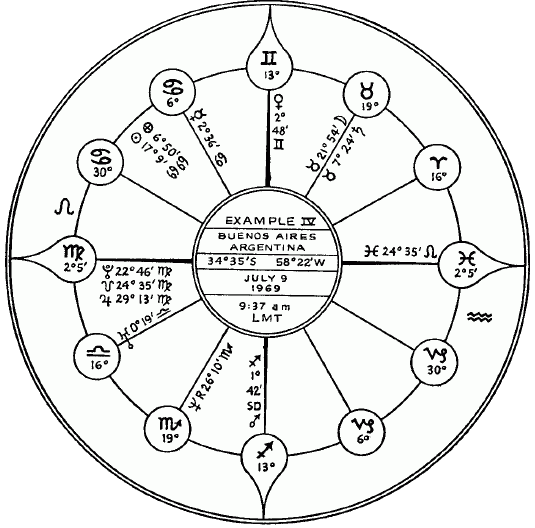
Time difference: 3h 53m
Greenwich mean time: 1:30 p.m.
Summary
There are two phases in putting the planets in their places in the horoscope. The first is merely a matter of changing the local mean time to Greenwich mean time in order to make the most simple use of ephemerides now universally computed for the prime meridian at Greenwich. The next phase is taking each planet in turn to find how far it moves in twenty-four hours and what proportional part of that movement is necessary for it to reach its place in the horoscope. The calculations in many instances can be by an uncomplicated fractional estimation, but when there are troublesome irregularities or complex figures as with the moon that always may be a convenient and easy use of the diurnal proportional logarithms.

Home | About | Blue Letters | Marc Edmund Jones | Greetings from Members | MEJ Books | Contact
Copyright © 1973-2014. All rights reserved.